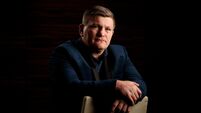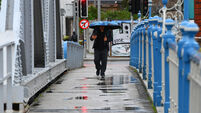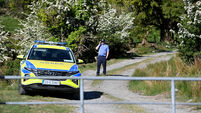Munich 1972: Witnesses to Olympic terror remember Munich horror
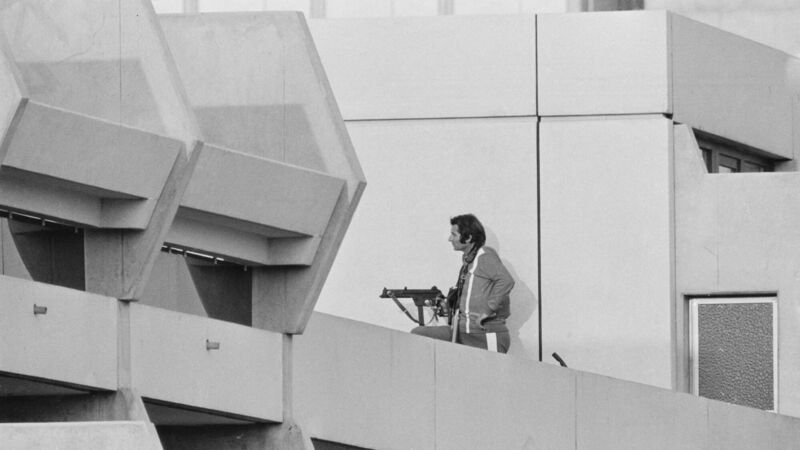
HORROR: An armed police officer maintains surveillance in the Athletes' Village during the 1972 Munich Olympic Games in Munich, West Germany, after Palestinian terrorist group Black September had taken hostages at the quarters of the Israeli athletes, 5th September 1972. Pic: McCabe/Express/Hulton Archive/Getty Images
Fifty years. Hard to imagine. For Mike Sands, Donie Walsh and Phil Conway, there are certain memories of the 1972 Munich Olympics that have long been washed away, lost in the vault among all that happened over the last half-century.
But then, there are certain images, feelings, that will never leave them.
Sands, a 200m sprinter from the Bahamas, was just 19 during the Games and he will never forget the sight of Dan Alon, an Israeli fencer, banging on the glass door to his apartment just after 4:30am on Tuesday, 5 September.
“Please, please, please, let us in,” Alon pleaded. “They’re killing my friends, they’re killing my friends.”
Conway, who competed for Ireland in the shot put, will never forget the “eerie silence of disbelief” that hung over the Olympic village the following day after the murders of 11 Israelis by Palestinian terrorist group Black September.
Walsh, who raced for Ireland in the marathon, will never forget waking up that Tuesday morning and hearing that just a few blocks away, a group of fellow Olympians was being held at gunpoint.
“It was still very sketchy,” he says. “I don’t think we’d TVs in the room, but the area was blocked off. It was a shock to the system.”
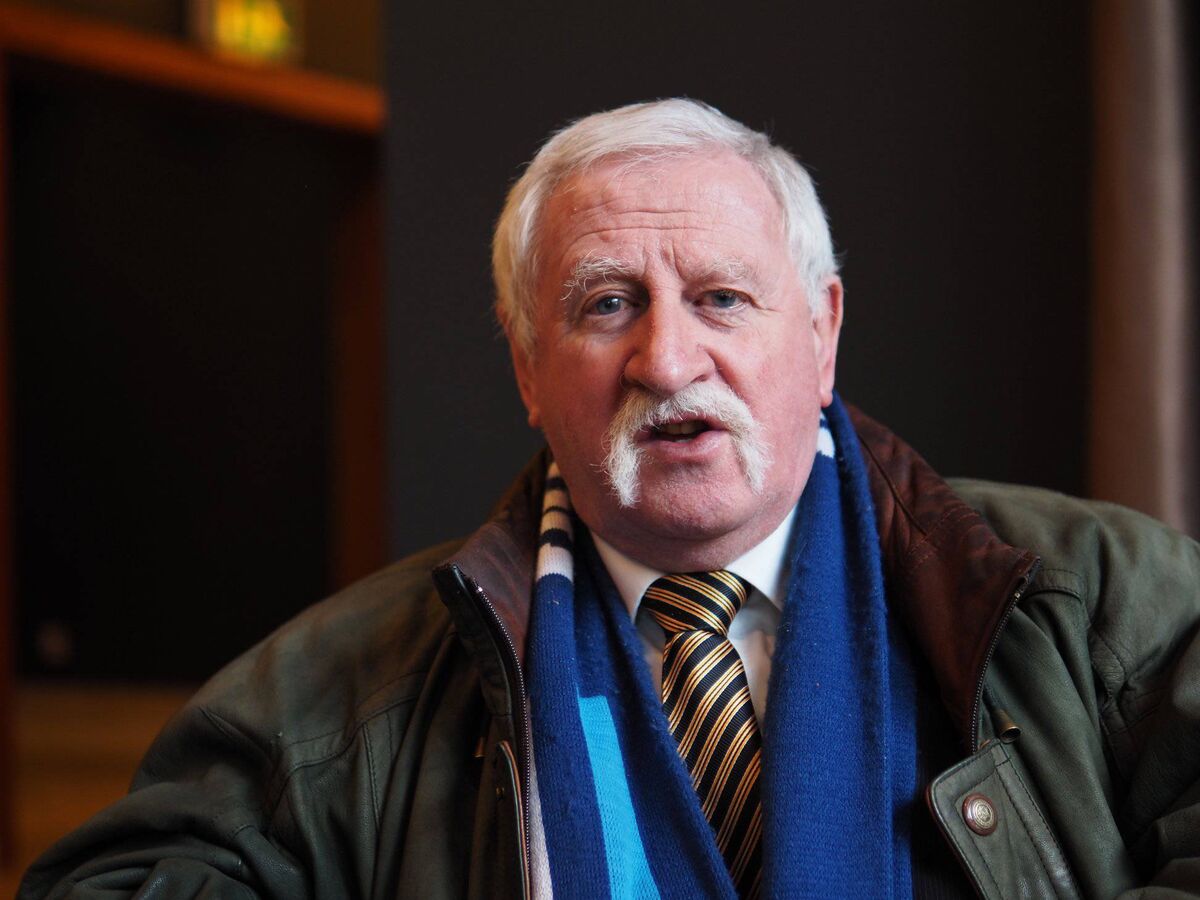
The night before, Walsh had ventured into the centre of Munich with a group of athletes to “break up the monotony of being in the village,” returning in the early hours. Not keen to make a long walk to the official entrance, he climbed over the two-metre chain-link fence surrounding the village.
He reckons it was only a half-hour later, in that very same area, when the eight terrorists – disguised as athletes and carrying duffel bags loaded with assault rifles, pistols and grenades – scaled the same fence. The perpetrators had been assisted, unwittingly, by a group of Olympians, with Canadian water polo player Robert Thompson saying years later they “assumed they were just other athletes.”
In the 1999 documentary the last surviving member of the Black September Commando, Jamal Al-Gashey, said: “The funny thing is, we actually helped each other to climb over.”
Al-Gashey and his seven colleagues then made their way to the Israeli quarters, using stolen keys to enter Connollystrasse 31, where Yossef Gutfreund, an Israeli wrestling judge, awoke to the sound of scratching at the door of apartment 1. As the gunmen began to force their way in, he threw himself in front of the door to try stop them, allowing one of his roommates a chance to escape through the window.
Another roommate, Moshe Weinberg, fought the intruders and after being shot through the cheek, he was forced to help the terrorists find more hostages. Weinberg led them past apartment 2, lying to the terrorists that there were no Israelis there, and on to apartment 3, his reasoning likely being that the wrestlers and weightlifters staying there stood a better chance in a physical confrontation.
But all were surprised in their sleep, the terrorists rounding up six more Israelis and marching them all back to the coach’s quarters. There they stayed, with nine hostages in all, having already killed a weightlifter who attacked them, Yossef Romano, his body left in front of his bound comrades as a warning.
It was around this time that Sands awoke to frantic thumping on his door. He and a Bahamian teammate, 100m sprinter Walter Callander, had fallen asleep the night before with the lights on in their apartment, which was likely the reason Alon – who’d been staying in apartment 2, the one the terrorists bypassed – chose their place to seek shelter.
Sands went to the glass door to talk to Alon, who motioned his arms to mimic a gun and kept repeating that same line: “They’re killing my friends.” “Who is?” asked Sands.
Alon pointed towards the stadium, instead of the athletes’ residences, which made Sands think he was drunk. “He obviously just got delusional or disoriented,” says Sands.
Callander told Sands to let him in, but Sands was initially sceptical. “Walter, if someone is chasing him with a gun, I’m not going to let him inside on the ground floor,” he said. He told Alon to go to the upstairs entrance, where they granted him access.
Alon explained using hand gestures that the terrorists were wearing masks and Sands used the apartment phone to call security, though the language barrier meant he wasn’t understood. At this point Timothy Barrett, a Bahamian triple jumper, got up and tried to explain in his limited German what was happening.
A soldier soon arrived at their door, with Barrett rehashing Alon’s story. “Show me,” said the soldier, and with that he, Alon and the three Bahamian sprinters walked back towards apartment 1.
“We’re walking behind the soldier, he’s leading, and (Alon) is very, very concerned,” says Sands. “He doesn’t want to be to the front.” The soldier, who was carrying a gun, knocked on the door. “When they cracked the door ajar, they stuck the gun out, literally inches from our face,” says Sands. “He said, ‘leave, you have no business here, leave now.’”
All five took off running down the corridor, returning to their apartment, with the soldier calling his superior to report what was happening. “He said, ‘stay here, nobody leave,’” recalls Sands. “We tried to go back to sleep but couldn’t. We didn’t understand what was happening. We didn’t understand it was as serious as it was.”
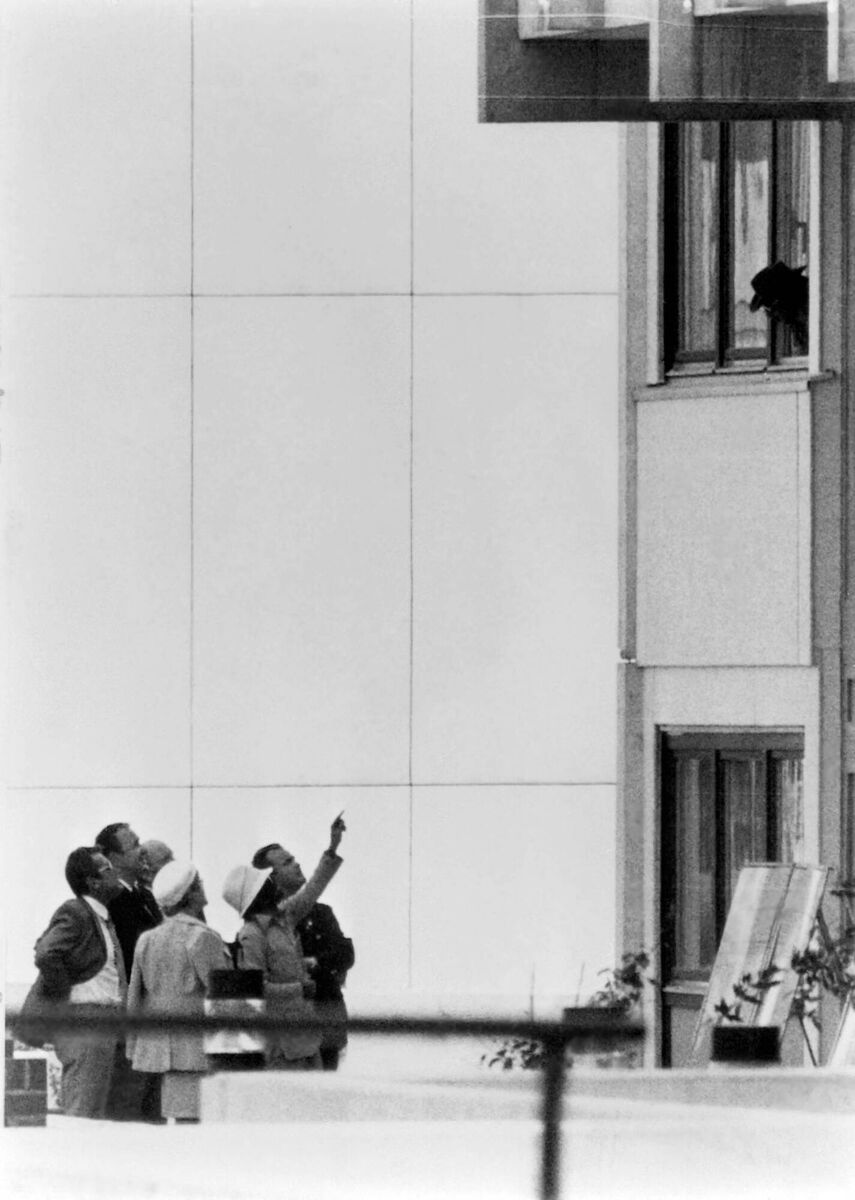
The Olympic accommodation had been arranged alphabetically by nation, and Phil Conway reckons the Israelis were only four units away from the Irish team. “But I have no recollection of seeing anyone on a balcony other than on a TV monitor – a fella in a mask,” he says.
Walsh remembers a sense of confusion as the athletes awoke to the news. “No one knew anything,” he says. “I’d say the people in Ireland knew more what was going on. The area was cordoned off and we weren’t allowed near it.”
Before the incident, the Olympic village had been a Utopian place, with so many strands of differing societies mingling as one. “The vibe was very relaxed,” says Walsh.
But that Tuesday morning, everything changed. The terrorists were demanding the release of 234 Palestinians and non-Arabs who were jailed in Israel, but Israel was adamant: there would be no negotiation. The terrorists refused unlimited financial offers from German authorities to release the hostages, reportedly saying “money means nothing to us; our lives mean nothing to us.”
At 4:30pm, 12 hours into the siege, a squad of police officers dressed in tracksuits were dispatched to kill the terrorists, but given the footage of them taking up positions around the apartment was broadcast live on TV, it was a move the perpetrators could see coming. After a warning from the terrorists that they would execute two hostages if they didn’t retreat, the police backed off.
The Palestinians demanded transportation to Cairo and, at 10pm that night, believing they had reached an agreement, they led their bound and blindfolded hostages into buses. Sands remembers looking out from his apartment at the Israelis being led away and how they waved to their fellow athletes. “It was heart-wrenching,” he says. “They realised they were probably going to their deaths.”
The buses transported them to helicopters, which flew them to Furstenfeldbruck Air Base, 15 miles away, where police were waiting with a team of snipers. On the tarmac at the air base was a Boeing 727 and, at 10:30pm, two of the terrorists went to inspect the airplane they believed would fly them to Egypt. Finding it empty and realising they’d been deceived, they shouted to their colleagues, at which point police opened fire, with several terrorists and one police officer killed.
At midnight, a German official announced that all the hostages had been freed and the terrorists killed, news that spread around the world, but which was totally, tragically untrue. Soon after, a terrorist threw a grenade into one of the helicopters, killing all Israeli hostages onboard, while a second opened fire inside the other helicopter, murdering the five remaining Israelis.
By 12:30am it was all over, with 11 Israelis killed along with one policeman and five terrorists, an additional three members of Black September captured by police. Just under three hours later, ABC host Jim McKay, who’d been broadcasting from the Olympic village for 14 hours straight, told much of the world the news it was dreading.
“When I was a kid, my father used to say, ‘Our greatest hopes and our worst fears are seldom realised,’” he said. “Our worst fears have been realised tonight. They've now said that there were 11 hostages. Two were killed in their rooms yesterday morning, nine were killed at the airport tonight. They're all gone.”
The Games were suspended for 34 hours, with a memorial service held the following day at the Olympic Stadium attended by 80,000 spectators and 3,000 athletes. Willi Daume, president of the Games’ organising committee, called for the Olympics to be cancelled but in the end, International Olympic Committee president Avery Brundage got his way.
“The Games must go on,” he said.
Most athletes were in favour of that, but not all. The remaining members of Israel’s team withdrew, as did Dutch distance runner Jos Hermens. “It’s quite simple,” he said. “We were invited to a party, and if someone comes to the party and shoots people, how can you stay?”
Sands had finished competing by that point, but he remembers being against the decision to go on: “I said to my friend, ‘if people are killed, why are we still going to compete?’” He remembers a “very sombre” mood in the village, though he felt his spirit rising when watching the memorial ceremony on TV and catching sight of Alon sitting alongside other surviving Israelis.
Sands can also recall the scene as Mark Spitz, a Jewish-American swimmer who’d won seven gold medals at the Games, was escorted out of the village. “He literally had an army of bodyguards around him, more than the president of the United States would have,” he says.
In the Irish camp, the feeling was that stopping the Games would be a concession to the terrorists. “I don’t recall anyone wanting to go home without earning the title or tag of being an Olympian,” says Conway. “The journey for many had been long. You have to hand it to Lord Killanin (the then-president of the Olympic Council of Ireland) who was a very strong presence and very good to assure people the Games would go on. Wars had interfered with them after ’36, the next one was ’48, so they were determined that sport should win out, not politics.”
For Walsh, the decision to compete was a straightforward one. “You couldn’t leave terrorists win, and that was it,” he says. “We didn’t even think (about withdrawing). The thing was to go ahead, because you can’t give in to terrorists and people who want to disrupt things.”
Walsh had a rough experience in the marathon a few days later. He had trained well coming into it, racking up 157 miles during one of the weeks he’d spent in Munich on the build-up, but in the race itself, he went for broke, following Frank Shorter, the US star who went on to win gold.
He had felt unwell the night before, having woken up several times to find himself covered in sweat. “But if I was going to the Olympics, I had to have a go,” he says. “I might never get a chance again so I went out to race. You don’t just go to championships to finish. I didn’t know any other way to run, I ran to win it.”
But on the biggest day of his career, his body betrayed him, Walsh running himself to a standstill, stepping off the course and into the back of an ambulance, where he was treated for dehydration. But while in there, something changed, a decision that was in keeping with the prevailing spirit across the Games. “I went, ‘nah, I have to finish,’” he says. “I started running again.” He made it to the Olympic Stadium, eventually, finishing 47th in 2:31:12.
Despite all that occurred, with the tragedy nearby, the disappointment over his performance, Walsh still holds fond memories of the Munich Games. “It was a great experience to go,” he says. “I used to not think when I was growing up that I’d ever go to an Olympics.”
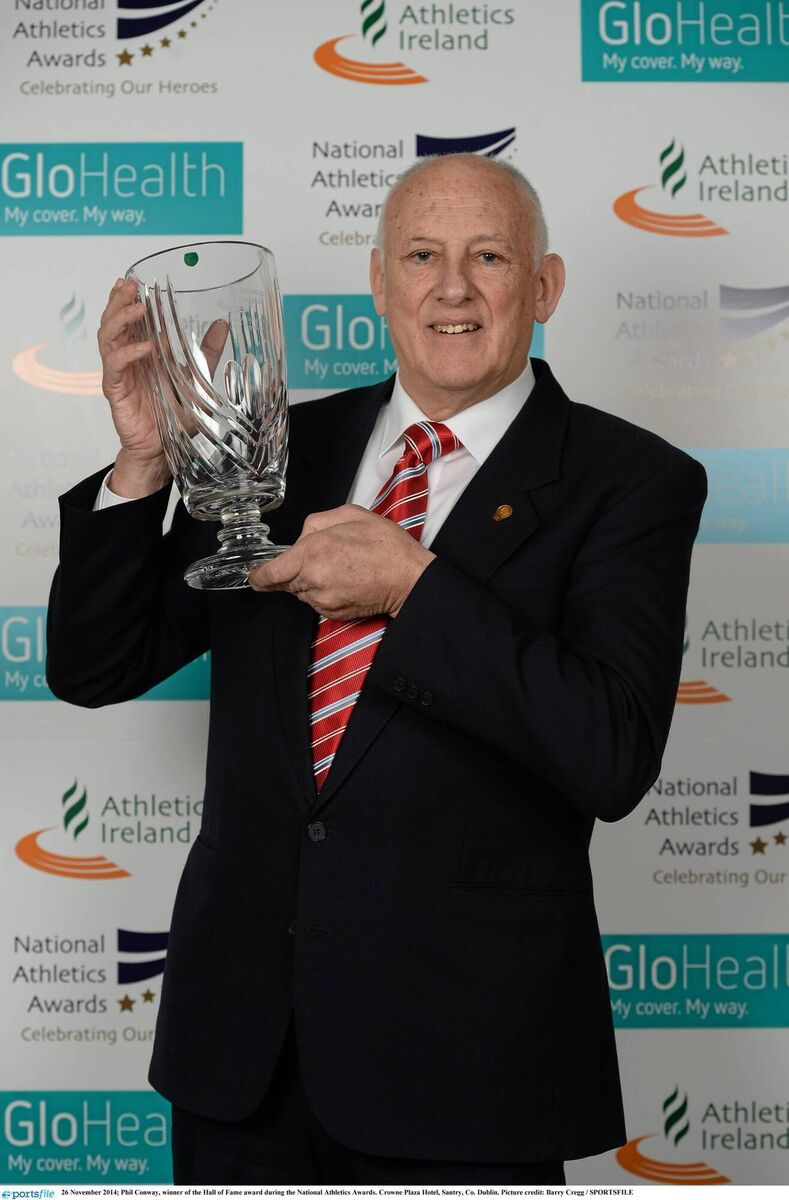
Conway had a similarly memorable experience, even if it was a similarly forgettable performance. The qualifying for the men’s shot put took place on 8 September, two days after the massacre, and he was well off his best, his longest effort of 16.69m placing him 27th of 29. “My achievement was qualifying with a B standard, but it was almost like going to the guillotine,” he says. “I didn’t sleep well the night before and it was possibly my worst performance – I tensed up.”
He can remember the strange atmosphere in the village as athletes tried to compartmentalise what had happened.
“Life went on, I suppose. There was a village newspaper and when you see the graphics, the explanations, it hit home a bit more. But it was only when people came home to Ireland or went around the globe and shared the stories that the awfulness of the whole thing really set in.”
Like the majority of Olympians, that was Conway’s one and only Olympics. Beyond the tragedy, he can still recall the beauty of the experience – the memories of the countless interactions still clear a half century later. “To be there, to see all the various sports, was absolutely fantastic,” he says. “It was a feast of athletic humanity.”
Sands is similar. He had finished competing by the time of the massacre and while that incident is front and centre of his thoughts when he reflects on 1972, he also remembers the positive things, like how it felt to be the flagbearer for his nation at the tender age of 19.
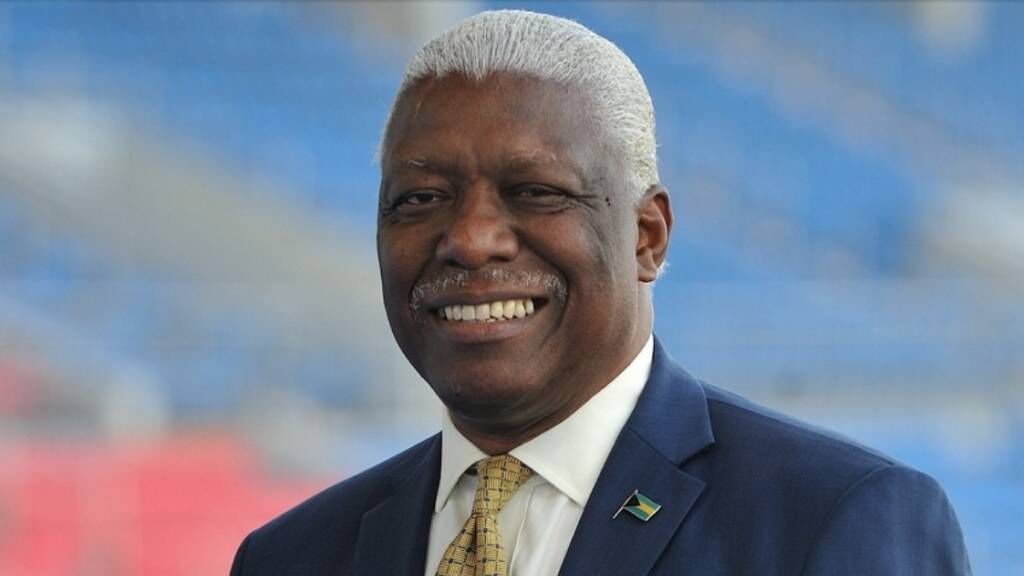
In recent years, he was reunited with Alon, who’d been invited along with another survivor to visit the Bahamas by one of the country’s Jewish citizens. As Alon was introduced on stage at a function, he was told a couple of special guests were also in attendance and up stepped Sands and Barrett, who had opened that door for him all those years ago.
“It was very emotional,” says Sands. “That was the first time we got back together and he told me he’d like to thank me and my friends for providing a safe haven. He was able to recount the story – it was heart-breaking and emotional.”
Alon passed away from cancer in 2018, at the age of 72. Many of Sands’ Bahamian teammates are also no longer around. Did the experience in Munich leave a scar?
“It was a traumatic event, but I don’t think it was a traumatic experience for us simply because we didn’t understand the magnitude,” he says. “As young boys, we did not understand we were a part of something as dramatic as that. You go to the Olympic games just to have fun and make friends for life.”
These days, Munich’s Olympiapark has stayed much the same as it was in 1972. A visit there for this month’s European Championships had the feel of stepping back in time through a grainy television set. The tent-like roof that shrouds the Olympiastadion is the same Plexiglas one that was there in 1972 – its transparent design symbolising openness, providing a contrast to the architecture of the 1936 Berlin Olympics and that of the Nazi regime.
A short walk from the stadium, on the way to the old Olympic village, there’s a memorial for the Munich massacre – a small, sombre site where the stories of the victims are kept alive through commemorative plaques. An 11-metre-wide screen there shows a 10-minute documentary on a loop, telling the story of the 20-hour tragedy that left an indelible, traumatic mark on the Games’ legacy.
On stone slabs, the victims’ stories are told in short essays, the words interspersed with images – some from their childhoods, some from their sporting careers.
At the bottom of each biography, there’s a personal memento. For Yossef Gutfreund, it’s a picture of the key to his Olympic apartment at Connollystrasse 31, where 50 years ago he used his body to block the door, buying his roommate precious seconds to escape and live a life he would be denied.
For fencing coach Andrei Spitzer, it’s the Olympic mascot toy, Waldi, which he’d bought for his daughter Anouk while in Munich. For weightlifter Ze’ev Friedman, it’s a postcard he sent from Munich on 26 August, 10 days before his death. His parents only received it weeks later, the note signed off with a poignant line that evokes as much pain now as it must have then: “See you soon at home.”





